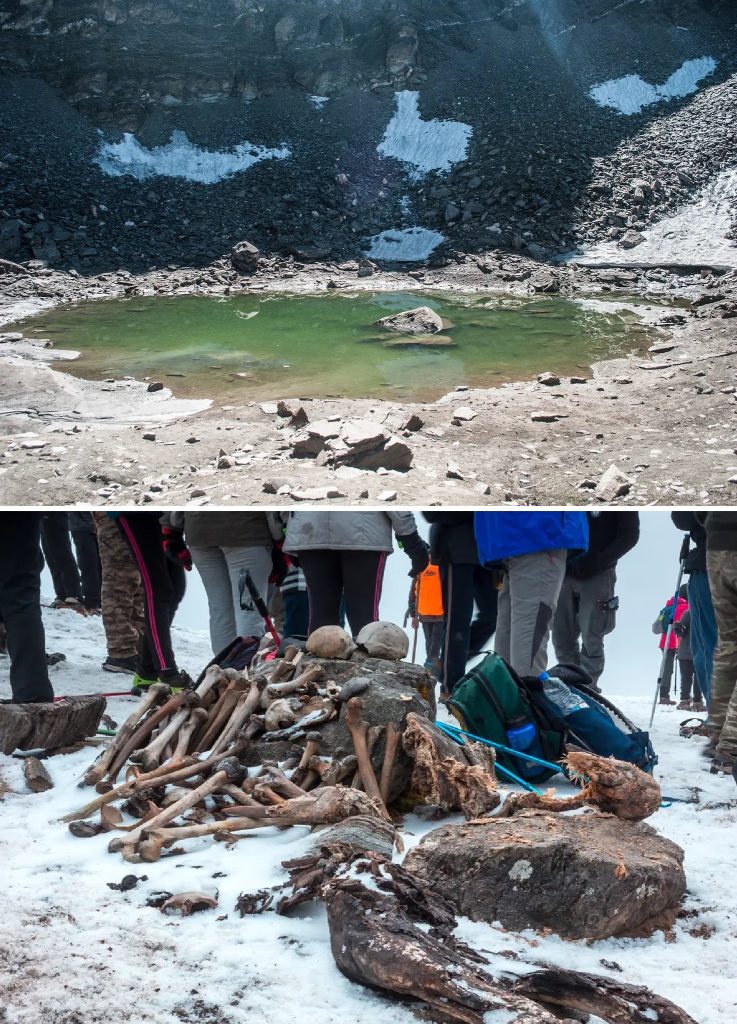High in the towering peaks of the Indian Himalayas, more than 5,000 meters above sea level, lies a mysterious glacial lake that, at first glance, appears serene and beautiful. But beneath its icy surface hides a haunting and tragic secret that has puzzled scientists and historians for decades. This place is called Roopkund Lake—though many know it by a far more chilling name: Skeleton Lake. Each year, as the snow and ice melt away during the short summer months, a shocking sight emerges—hundreds of human skeletons scattered around the lakebed, preserved for centuries in the frozen environment.

The first modern discovery of these skeletal remains occurred in 1942, when a British forest ranger stumbled upon a gruesome scene—over 200 human skeletons lying exposed at the water’s edge. At a time when World War II raged across the globe, the discovery led to an immediate military investigation. Some initially suspected that the remains belonged to Japanese soldiers who had attempted a covert invasion through the Himalayas. However, this theory was soon dismissed, as further exploration revealed the remains were far older than anyone expected.
As the decades passed, the mystery deepened. More than 800 skeletons were eventually identified, scattered across the lake and its surroundings. Researchers were left with countless questions. Who were these people? Why were they there? And what had caused so many to perish in such a remote and unforgiving place? Theories swirled. Some believed the lake marked the site of an ancient epidemic that struck down a group of travelers. Others speculated it was the result of a ritual suicide or mass sacrifice. Still others leaned on folklore—local legends told of a royal pilgrimage that had offended the mountain goddess Nanda Devi. The tale said that the travelers had danced and celebrated in sacred lands, prompting divine wrath in the form of deadly hail from the heavens.
For many years, these stories and hypotheses remained unproven. But everything began to change in the early 2000s, when scientists from India, Germany, and the United States launched an international research effort to uncover the truth. In 2003, a team of experts descended upon Roopkund Lake to conduct a series of detailed studies using modern scientific techniques. They collected bone samples and analyzed the remains using radiocarbon dating, mitochondrial DNA testing, and isotope analysis to trace the origins of the individuals.
What they found was nothing short of extraordinary. The DNA evidence showed that the remains belonged to two distinct groups of people. The first group was made up of shorter individuals, likely locals who may have served as guides or porters. The second group consisted of taller people with genetic markers linked to a population from present-day Maharashtra, in central southern India—nearly 800 miles from Roopkund. Radiocarbon dating placed their deaths around 850 AD, revealing that these individuals had perished more than 1,100 years ago. This supported the theory that they were pilgrims on a sacred journey through the mountains, traveling to pay homage at a nearby shrine dedicated to the goddess Nanda Devi.
However, even with these revelations, one question remained: what had killed them all so suddenly? The answer lay in the bones themselves. Researchers found that many of the skulls showed identical injuries—deep cracks and depressions located at the back of the head. These were not wounds from weapons or falls. Instead, the injuries were consistent with being struck by large, round objects falling from above. Scientists eventually concluded that the cause of death had been an intense hailstorm, with hailstones possibly as large as cricket balls falling at high speed, estimated at over 100 miles per hour (160 km/h). In the open alpine landscape, with no shelter and no chance of escape, the entire group was overwhelmed in a single catastrophic weather event.
The story of Roopkund Lake is both tragic and remarkable. It is a somber reminder of how nature—beautiful and majestic though it may be—can turn deadly in an instant. The unique conditions of the lake, from its high-altitude isolation to its year-round freezing temperatures, created the perfect environment to preserve these ancient remains, essentially freezing this historical event in time for over a millennium. The bodies, clothing, and even wooden artifacts were found well-preserved, giving modern scientists a rare window into the lives and final moments of people who lived centuries ago.
Today, Roopkund Lake continues to fascinate not only scientists but also adventurers, trekkers, and spiritual seekers from around the world. Its haunting beauty and the mystery that surrounds it make it one of the most compelling archaeological sites on Earth. Yet the lake’s remote location, accessible only through challenging and perilous terrain, ensures that it remains largely untouched, a natural crypt high above the world. Only during the brief thaw each year do the skeletons appear again, silently telling their story to those brave enough to reach them.
In many ways, Roopkund is more than just a historical curiosity—it is a powerful symbol of humanity’s vulnerability in the face of nature’s wrath. Despite all our modern achievements and technological advances, the events at Roopkund remind us of the fragile thread upon which human life hangs, especially when confronted by the raw forces of the natural world. As scientists continue to study the lake and its surroundings, more discoveries may come to light. But for now, the silent witnesses of Roopkund remain frozen in time, their story echoing across the centuries, offering us a deeper understanding of the past—and a profound respect for the power of nature.





